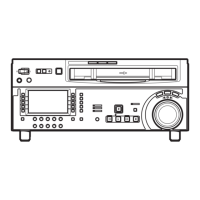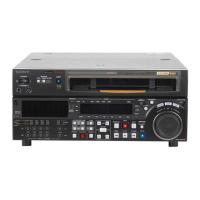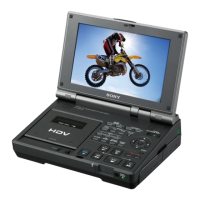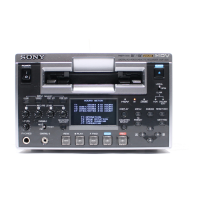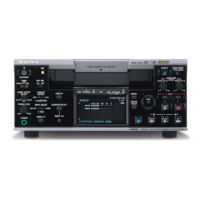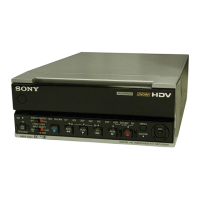Do you have a question about the Sony HDW-M2000 and is the answer not in the manual?
Details the unit's capabilities, digital signal processing, interfaces, and audio features.
Illustrates a conceptual diagram showing typical external device connections and usage.
Describes the three main control panels: Upper, Lower, and Switch panels.
Lists and describes various input/output connectors for analog, digital audio, video, and external devices.
Guides on connecting digital devices, reference video input, and remote control interfaces.
Explains how to select and connect reference signals for proper synchronization.
Outlines principal setup operations using basic and extended setup menus.
Details information displayed on the video output, including time code and menu settings.
Covers cassette types, inserting, ejecting, and preventing accidental erasure.
Explains how to insert, remove, and notes for using Memory Sticks with the VTR.
Describes video and audio recording procedures, including preparations and time code settings.
Covers playback procedures, including preparations, normal playback, and various speed modes.
Explains how to vary playback speed for sections and store it in memory.
Guides on carrying out automatic editing with another VTR, covering modes, edit points, and operations.
Details how to achieve variable speed editing by controlling player playback speed.
Covers methods like quick, continuous, standalone, manual, and preread editing.
Introduces shot mark types, reading, writing, list operations, cuing, data display, and sorting.
Explains the four items within the shot mark operation menu and how to change settings.
Covers reading, writing, list operations, cuing, reading shot data, and sorting shot marks.
Introduces Tele-File as a non-contact data carrier system for data management.
Describes how to access the Tele-File menu via the function menu or automatically.
Details operations within the Tele-File menu, including clip data display and modification.
Explains UMID as meta-data for video/audio materials, its structure, and availability.
Covers selecting UMID type, generation methods, and setting Stored Ownership.
Guides on how to output and display UMID data on the control panel and video monitor.
Explains the purpose of the function menu for settings like input signals and time codes.
Lists and describes items available on the HOME page and subsequent function menu pages.
Outlines the basic and extended setup menus and their respective item groups.
Details procedures for displaying menus, changing settings, and exiting setup.
Advises on removing cassettes with tape slack, recommending professional service.
Instructs on using the specific cleaning cassette and its operation.
Explains how error messages are displayed and how to contact service.
Describes moisture detection, error display, and precautions when moving the unit.
Guides on using the digital hours meter and understanding maintenance timings.
Lists detailed technical specifications for the unit's general features and tape transport system.
Lists optional accessories available for purchase, including control panels and interface boards.
Details the unit's capabilities, digital signal processing, interfaces, and audio features.
Illustrates a conceptual diagram showing typical external device connections and usage.
Describes the three main control panels: Upper, Lower, and Switch panels.
Lists and describes various input/output connectors for analog, digital audio, video, and external devices.
Guides on connecting digital devices, reference video input, and remote control interfaces.
Explains how to select and connect reference signals for proper synchronization.
Outlines principal setup operations using basic and extended setup menus.
Details information displayed on the video output, including time code and menu settings.
Covers cassette types, inserting, ejecting, and preventing accidental erasure.
Explains how to insert, remove, and notes for using Memory Sticks with the VTR.
Describes video and audio recording procedures, including preparations and time code settings.
Covers playback procedures, including preparations, normal playback, and various speed modes.
Explains how to vary playback speed for sections and store it in memory.
Guides on carrying out automatic editing with another VTR, covering modes, edit points, and operations.
Details how to achieve variable speed editing by controlling player playback speed.
Covers methods like quick, continuous, standalone, manual, and preread editing.
Introduces shot mark types, reading, writing, list operations, cuing, data display, and sorting.
Explains the four items within the shot mark operation menu and how to change settings.
Covers reading, writing, list operations, cuing, reading shot data, and sorting shot marks.
Introduces Tele-File as a non-contact data carrier system for data management.
Describes how to access the Tele-File menu via the function menu or automatically.
Details operations within the Tele-File menu, including clip data display and modification.
Explains UMID as meta-data for video/audio materials, its structure, and availability.
Covers selecting UMID type, generation methods, and setting Stored Ownership.
Guides on how to output and display UMID data on the control panel and video monitor.
Explains the purpose of the function menu for settings like input signals and time codes.
Lists and describes items available on the HOME page and subsequent function menu pages.
Outlines the basic and extended setup menus and their respective item groups.
Details procedures for displaying menus, changing settings, and exiting setup.
Advises on removing cassettes with tape slack, recommending professional service.
Instructs on using the specific cleaning cassette and its operation.
Explains how error messages are displayed and how to contact service.
Describes moisture detection, error display, and precautions when moving the unit.
Guides on using the digital hours meter and understanding maintenance timings.
Lists detailed technical specifications for the unit's general features and tape transport system.
Lists optional accessories available for purchase, including control panels and interface boards.
| Recording Format | HDCAM |
|---|---|
| Audio Channels | 4 |
| Timecode | LTC, VITC |
| Power Requirements | AC 100-240V, 50/60Hz |
| Playback Format | HDCAM |
| Video Input | HD-SDI, Composite |
| Video Output | HD-SDI, Composite |
| Video Signal | Composite |
| Audio Signal | Analog Audio |
| Input/Output | HD-SDI |


